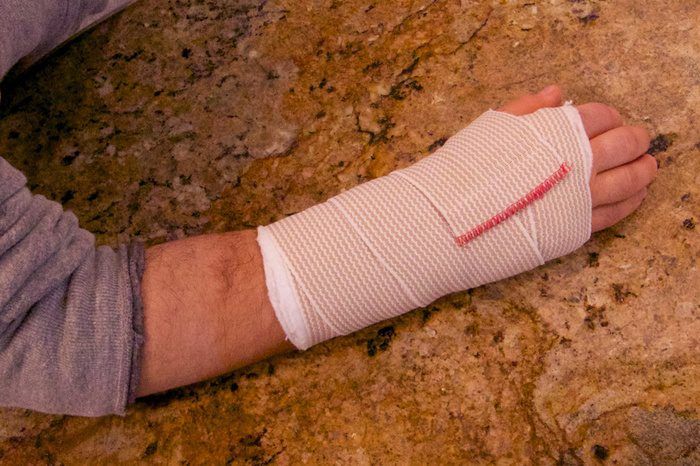Rage Against the Machine
These are crazy times indeed. Like everyone, Covid-19 has affected our business in profound ways. Luckily, construction has remained relatively steady, and aside from the mandatory shutdowns for the public side of our company, we were still able to remain somewhat active as we service both Washington and Idaho, construction remaining an essential service for the latter of the two. What we didn’t anticipate (how could we?) is how the pandemic would affect a major expansion of our factory capabilities that were set in motion before the world was turned upside down and slapped senseless.
Several years ago, we began a strategic timeline to diversify a sector of our company into architectural stone processing, focusing on the national market. Having the right technology, a large enough shop, good designers and drafters, along with established sources for buying cubic material and the ability to hand sculpt allowed us to “tick” all the boxes to pursue this type of work with a reasonable chance of success. After dipping our toes in these waters by mastering the software and capabilities of CNC technology early in our career, we knew that we could do this but were seriously restricted when processing stone thicker than 8”, although we did a pretty good job with what we had up to that point.

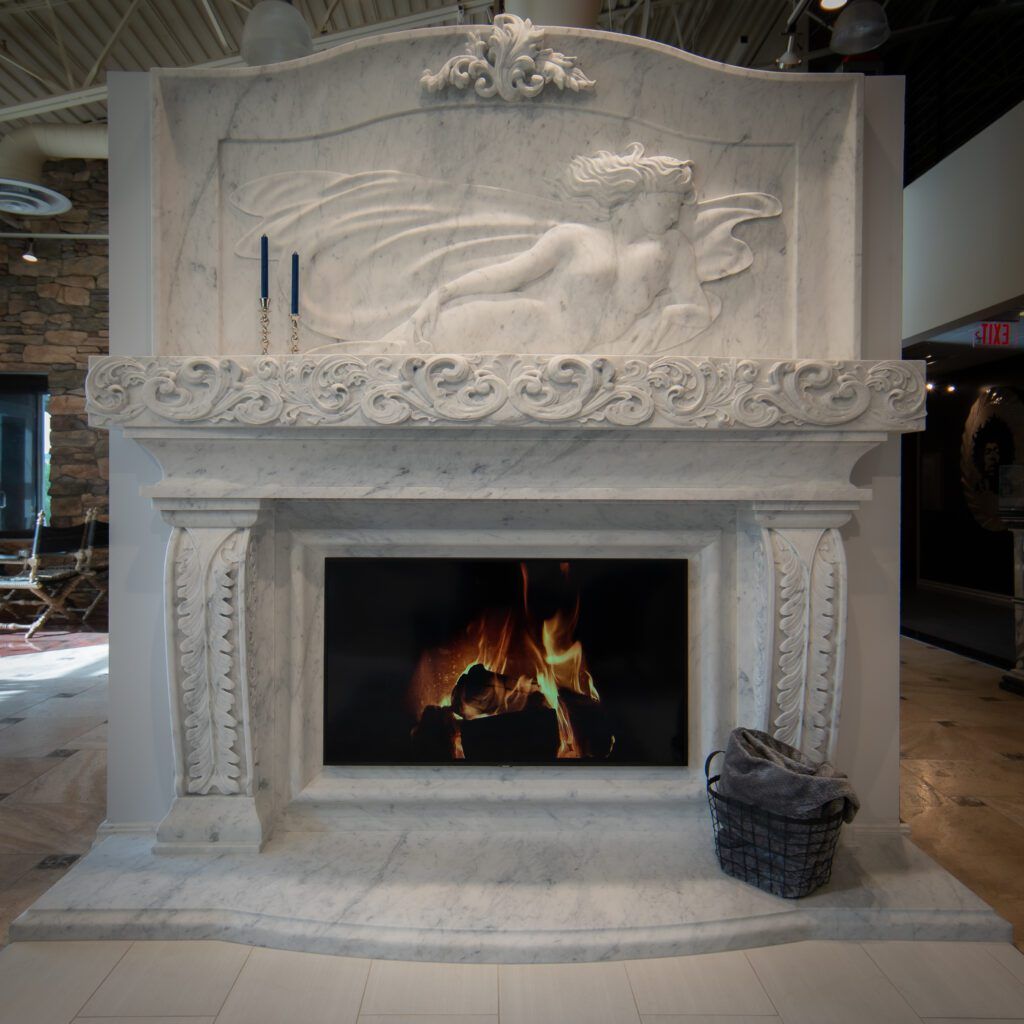
We wanted to be free of the processing constraints we were experiencing and have the ability to seek larger and more challenging commercial endeavors. After a productive meeting with a manufacturer while in Verona Italy, the decision to jump in with both feet was made in Autumn of 2019 as we pulled the trigger on a new 6 axis, fully interpolated shape mill, a monstrosity of a machine capable of working stone up to 78” thick, with an integral CNC lathe for turning ornate columns up to 11 feet long. For the readers not versed in CNC machining:
CNC: Computer numerical control. Material machining through software and robotics.
Axis: The movement of which a selected tool can work (aside from the rotation of the tool itself.) Up & down (Z), side to side (X), forward and back (Y), angle (W), head rotation (R), lathe rotation back & forth, incremental (B).
Interpolated: The ability for all axes to move simultaneously, allowing the tool to approach the workpiece from any trajectory, working along straight or curved paths in three dimensional space.
So as January ushered in the new decade, I found myself as usual at the annual North American stone show in Las Vegas (TISE). Little did I know it would be the last time I would be traveling for quite a while. Normally when we procure a piece of machinery, it is a meticulously planned out process. At these trade shows, most of the machines there are sold long before they arrive. As fate would have it, two of the Italian companies had their clients cancel their orders for one reason or another. In these situations, the manufacturer really can’t send them back after the show. They have to find other buyers, and fast. For us, acquiring this equipment was in our future plans to replace some of our aging production systems, and solving this early would save on relocation expenses making way for the new shape mill, saving a lot of headaches in the grand scheme of things. We would also bypass the typical six to nine month wait time needed to build and ship the machines if we ordered them through the normal channels. Long story short, they made us an offer we couldn’t refuse, we crunched the numbers, it worked, we bit.
So now we had planned on one machine on its way, yet had three, two of which arriving in mere days. These are not “plug and play” pieces of equipment, and the 6 axis shape mill required a lot more planning and preparation beyond the usual.
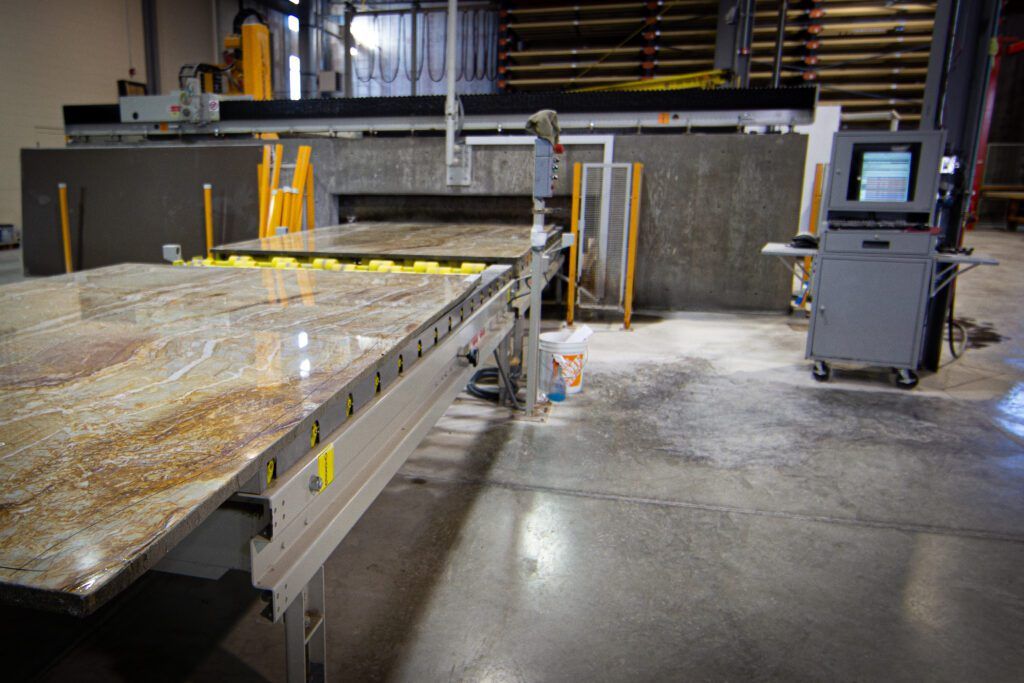
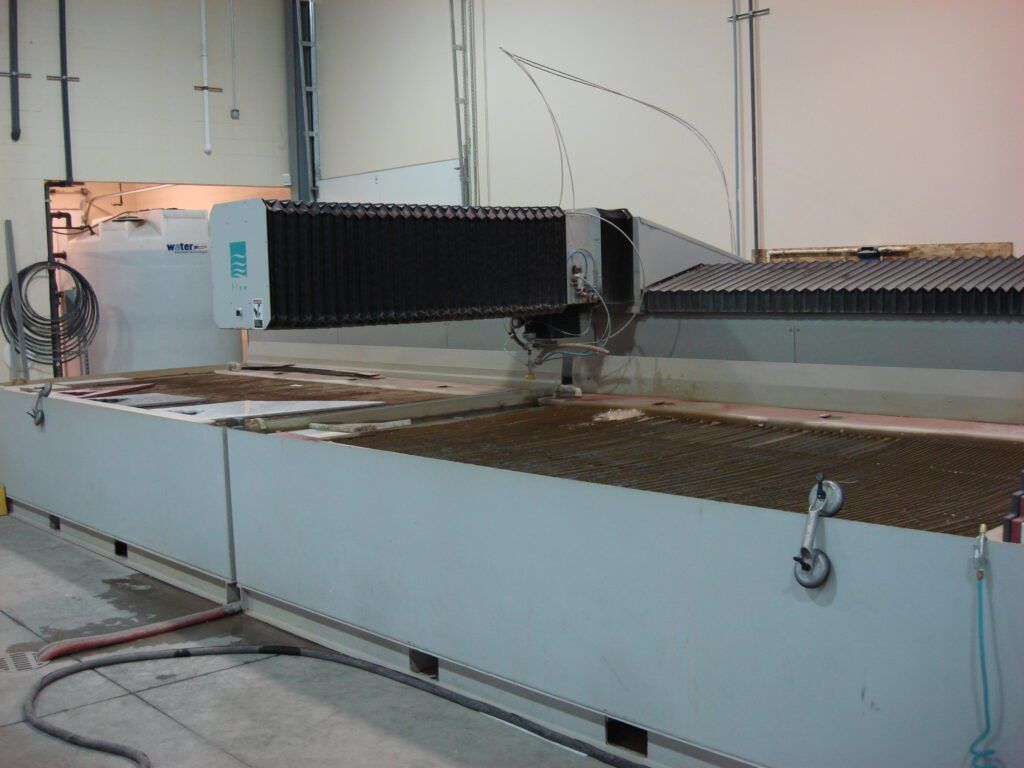
The old equipment being replaced had to be disassembled and stored inside being that it was winter, inconveniently in the way of the other operations taking place until it could be sold. In the end we sold off what we could, while some being so specialized we couldn’t find a buyer and ultimately had to be disposed as scrap. I won’t lie, seeing a once state-of-the-art, $300,000 bridge saw turned into a couple hundred bucks of scrap metal hurts just a bit. I once naively thought as a young fabricator that you purchased a piece of machinery to provide a solution to a problem and that issue was solved forever. Being constantly exposed to stone grit and water, this industry is tough on equipment, but beyond that and what I didn’t realize then is what role obsolescence would play. Technology advances rapidly, and that evolution can be significant to your production schedule. This is especially true of the stone industry in the last decade or so. Factory upgrades are an unavoidable reality if one wants to remain competitive and stay at the front of the pack.
We began in earnest the very loud and obnoxious jackhammering (just ask the office gals) of the concrete floor to create the substantial foundation and walls for the shape mill, now built and on it’s way from Gravellona Toce Italy, as well as the simultaneous demolition of the existing concrete saw walls to make room for the other new machines. Running new electrical, plumbing service and relocating drains followed. We also had to enhance and upgrade our water system to be able to keep up with the demands of this new equipment, adding more powerful pumps from Water Treatment Technologies and new 3” supply lines overhead feeding the factory. With everything running, our shop consumes 250 gallons of water a minute, every gallon recycled continuously. We try to be as environmentally friendly as possible.

Under the floor we discovered that the electrical lines for our overhead cranes were inaccurately located on the building plans. (The never-ending curse of going with the “low bidder”.) Of anywhere in a 44,000 square foot shop, they had to miraculously appear right where we wanted to dig. Luckily the electricians were able to remedy the situation without too much trouble. One more surprise expense of an expansion already nearing seven figures.



The first piece of equipment, a Comandulli edging machine, arrived ahead of schedule on Monday morning. We had arranged to have a crane company on site to unload it on Wednesday, along with a Breton 5 axis Combicut, also scheduled to arrive then as they were both coming from the Las Vegas trade show. For some reason, the truck driver couldn’t understand why we couldn’t just snap our fingers and conjure up a rigging company at will to offload the machine. After a good hour or so of arguing, he finally understood that it not only wouldn’t happen, but couldn’t, and simply dropped the semi trailer off with the machine covered in the parking lot. Chaos ensued on Wednesday as the semi with the other machine arrived, jockeying for space with the other trailer blocking the parking lot, the rigging company’s crane and support trucks, the concrete guys tearing up the floors, electricians running power lines, plumbers doing their thing and our installers trying to load up in the middle of all this. What else? Oh I know, how about a heavy snowfall just to make everyone’s job a bit more miserable?
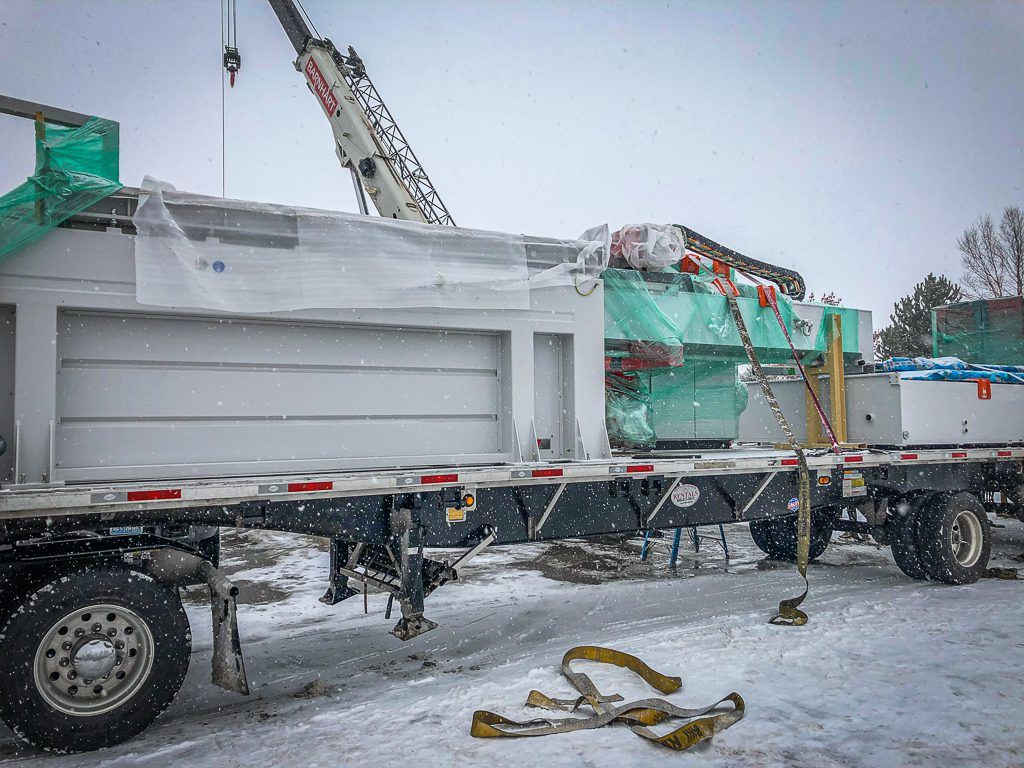
The edging machine was the first to be installed and went in without a fuss. But just as our shape mill was delivered and the technician arrived to install the Combicut, Covid-19 made its grand, uninvited entrance and crashed the party.
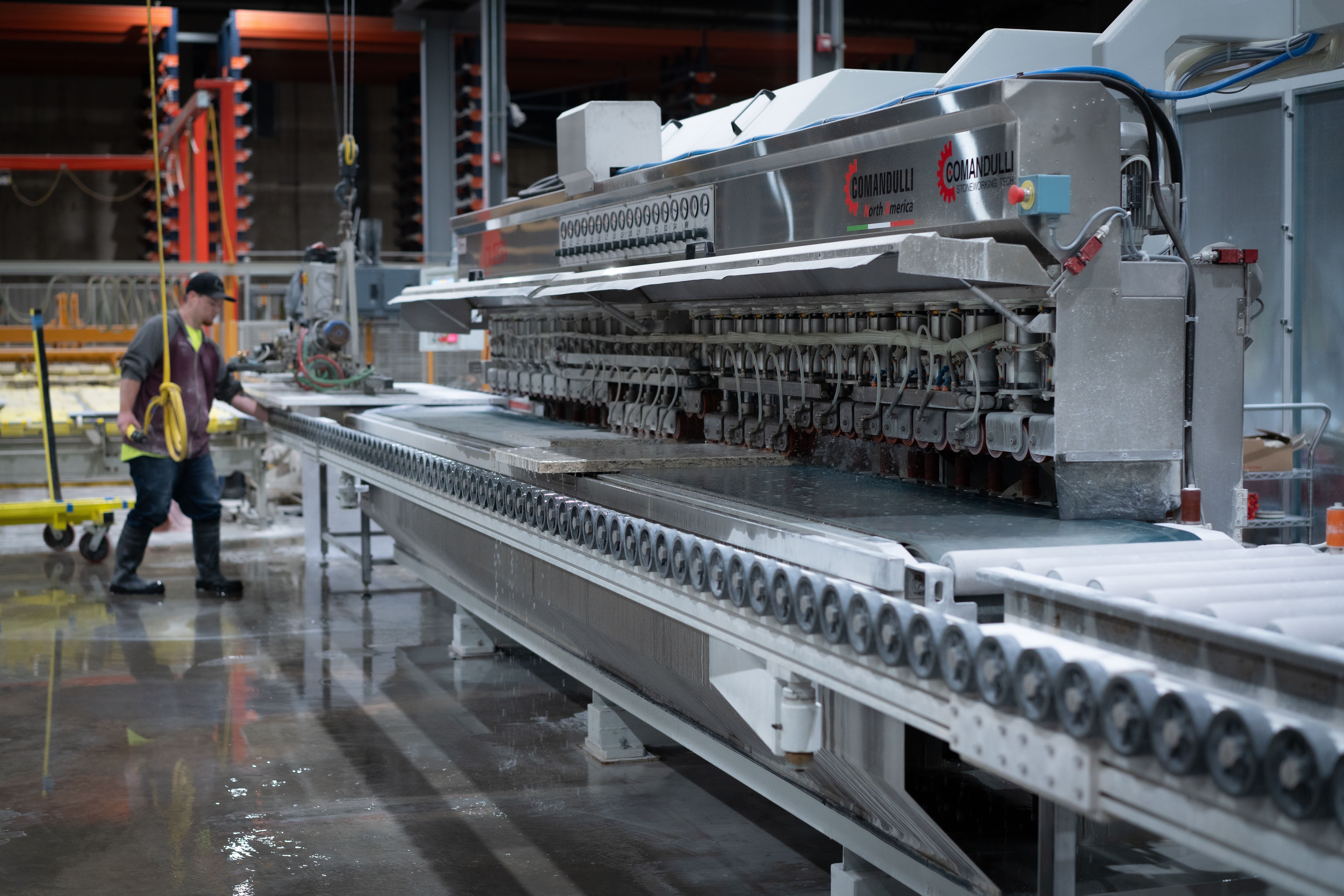
Breton’s technician for the Combicut was able to get it installed and operational before our governor shut everything down. So we had an operating machine, but little training. It was two months before he was able to return.


The 6 axis shape mill was by far the most disruptive. Because of the size and complexity of it, the manufacturer wanted to send a technician directly from the factory in Italy as opposed to their usual US based technicians. The problem was a travel ban between the US and Italy (and still ongoing as of this writing).
The concrete walls and the disassembled saw sitting adjacent to them takes up a sizable portion of the shop, now completely unusable. It remained this way for over four months, sitting there, taunting us. During this time, we navigated our own Covid reality of government-imposed closures, playing semantics with Governor Inslee over the word essential, and liberally dousing everything in isopropyl alcohol and bleach daily, ever so-slowly returning to a “kind-of” normal operation over the next few months.

After four months and still no end to the travel ban in sight, GMM (Gravellona Macchine Marmo), the manufacturer of our 6 axis shape mill called on their most senior US based sales manager, Taf Wharton, having years of installations and experience under his belt, to leave the office in Charlotte for a few weeks to install our equipment under Italian support via FaceTime, Zoom or the current gizmo du jour. Taf’s a good “bloke” I’ve known for years. Think “Italian speaking, lumberjack-looking guy with an Australian accent” and you get the picture. “Ciao Mate!”



You will not find a machine like this anywhere in our local area. This gives us capabilities and capacities well beyond the reach of the typical stone fabricator. Custom bathtubs, sinks, fireplaces, statuary, columns and truly unique landscape features, with very little limitation in regard to working size. There is essentially nothing we can’t produce in our shop now.
This is a new problem though- since the saw head goes all the way to the ceiling, I had to put a warning sign up to avoid collision with the overhead crane. In a game of chicken between the saw and crane, the only loser would be me.

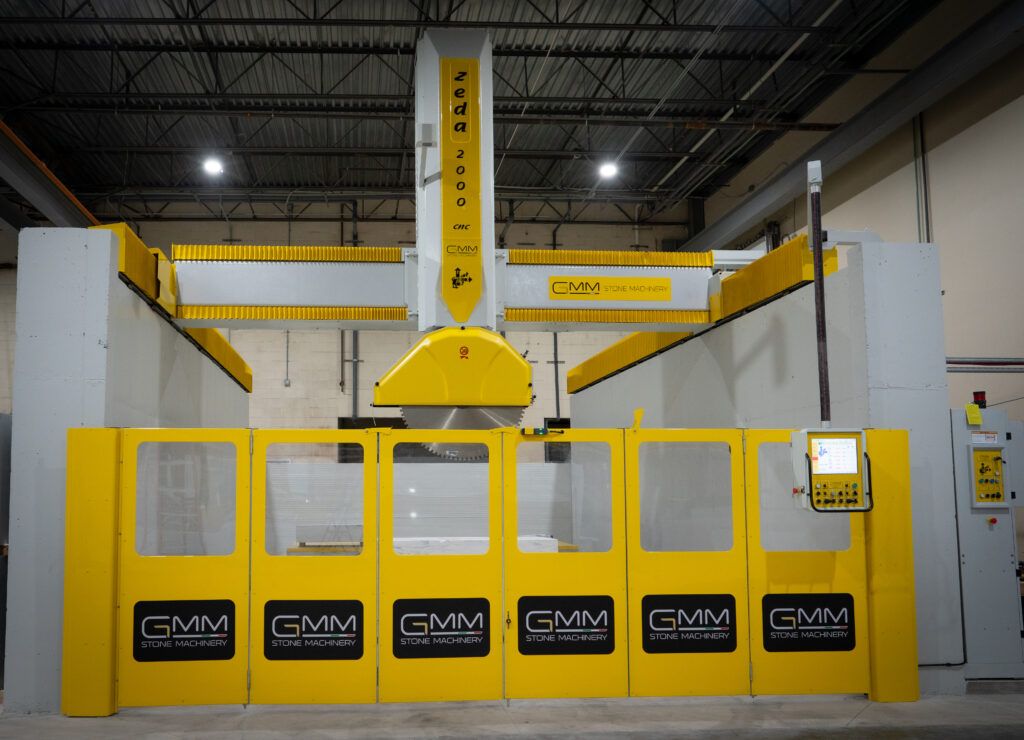
It’s now been almost one year since we signed the contract on the 6 axis behemoth, feeling like everything that could’ve went wrong did, thanks to that pesky little virus. But now with all the equipment finally up and running, our rage against the machine is over and we can get back to what we do best, making incredible stonework with a few liturgical projects already in the queue and some interesting and extremely ambitious projects on the horizon. You’ll want to keep an eye on my blog in the months ahead. To be continued…





